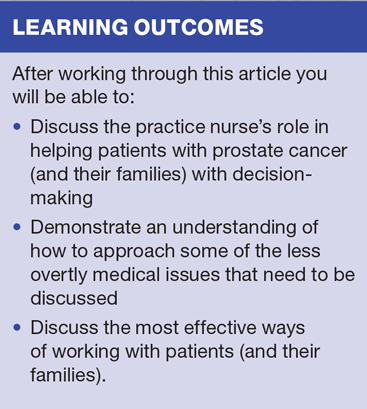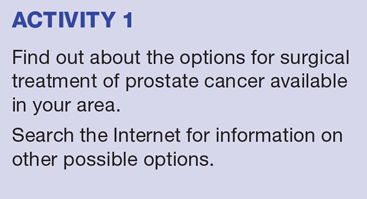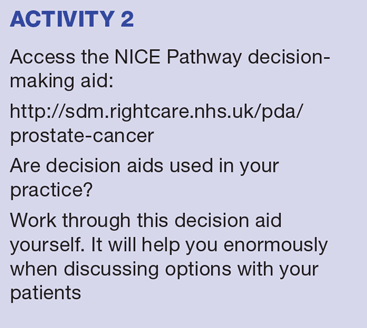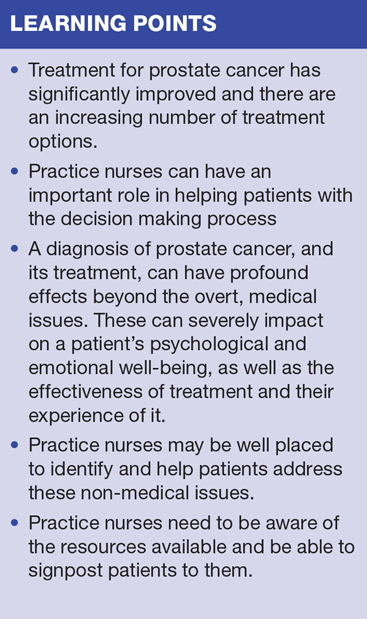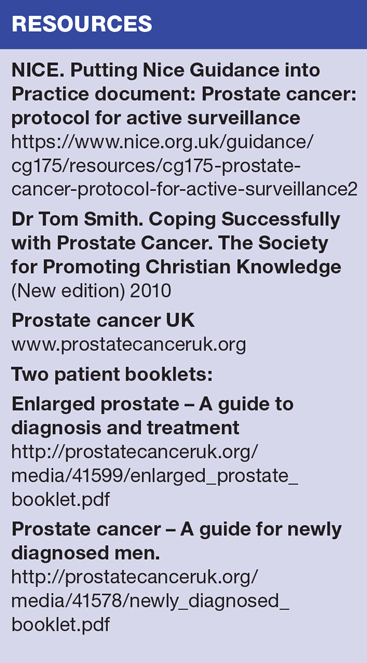
Prostate cancer and the practice nurse
Jim Pollard
Jim Pollard
Editor, menshealthforum.org.uk
Treatment for prostate cancer has improved out of all recognition in recent years, but with this progress, the challenges and choices for patients have also increased. Practice nurses, by understanding the prostate cancer patient, can make an enormous difference both to the effectiveness of treatment and the patient’s experience of it
The diagnosis and treatment of cancer has improved enormously over recent decades. The impact of these improvements on surviving patients is perhaps less well appreciated. Once upon a time it was acceptable to throw anything at cancer in the hope of delaying it a little. Now, life with and after the disease is increasingly common and there are a variety of treatment options that can impact on life in a variety of different ways. There are choices to be made, meaning that patients are now involved in cancer treatment as never before. Surely this is all good? Yes - but it brings with it its own challenges.
Patients are generally less aware than health professionals of the improvements in treatment. The ‘Big C’ still looms large in the popular imagination. It remains a disease of which people are frightened, and one that some would still rather not know they’ve got. What’s more, many patients, if not frightened of, are still in awe of some health professionals. They may not talk frankly to their consultant, which heightens the importance of your role in understanding how they truly feel and what they really want.
When we are talking about the three male-specific cancers – prostate, testicular and penile – there are a number of other ingredients to add to an already volatile cocktail of fear and outdated information. Men are generally reluctant to:
- Use traditional health services
- Confront their own mortality realistically, and
- Discuss their nether regions with anyone at all!
All this combines to ensure that working with men with male cancers is as challenging as it has ever been.
This article looks at the most common sex-specific male cancer – prostate cancer. It focuses less on the clinical aspects, which you will be familiar with from previous articles in this journal and the various NICE pathways and guidance, and tries to explore how men might be feeling and how you might best be able to support them.
FACT: MEN DON’T DO WELL WITH CANCER
Men don’t do well with cancer.1 Men have a 14% higher risk of developing cancer than women and a 37% higher risk of dying from it than women. To get a good like-with-like comparison, look at the cancers that men and women share – that is, all cancers excluding the sex-specific cancers and breast cancer. Men are 56% more likely to develop one of these cancers and 67% more likely to die from it. We don’t entirely understand the reason for this gender difference but it is surely possible that how men react to and experience cancer treatment, compared with women, may be a factor. If we can improve how men experience the cancer pathway we may be able to improve their outcomes.
THE STATISTICS
Of the three sex-specific male cancers penile cancer is the rarest and prostate cancer the most common. Penile cancer is very rare – around 500 cases in the UK every year.1 Testicular cancer is also quite rare – around 2,200 cases in the UK every year.2 Prostate cancer, by contrast, is the most common cancer in men, accounting for one in four male cancer cases – over 41,000 cases in 2011. The incidence is also increasing, up 16% since the start of the century.3
Cancer Research UK is confident enough to say: ‘Survival rates for prostate cancer have been improving for 30 years.’
In England, four in every five adult prostate cancer patients – 81.4% – survived their cancer for five years or more in 2005-2009. Nevertheless, prostate cancer is the second most common cause of cancer death among men in the UK. In 2012 there were 10,387 deaths from prostate cancer, 13% of all male cancer deaths.3
RISK FACTORS AND INCREASED RISK
Age
There is a close relationship between age and the risk of prostate cancer. One in three cases occur in men over 75, with a peak in the 75–79 age group.4
Less than 1% of cases occur in the under 50s. However, diagnoses of prostate cancer in men under 60, while still rare, have increased considerably over recent decades, nearly 6-fold in the last 20 years according to recent US research.5 There is evidence that younger men with prostate cancer may have more aggressive tumours. Indeed, the same research suggests younger men are likely to have ‘higher cause-specific mortality’ than older ones.5 Clinicians sometimes refer to tumours as ‘pussycats’ and ‘tigers’. The former may require no more than active surveillance while the latter are more likely to spread and need radical treatment.
Race
Race is a key factor in prostate cancer. The age-standardised rates for white males range from 96 to 99.9 per 100,000. The rates for Asian men are far lower (28.7-60.6 per 100,000) while the rates for Black men are much higher (120.8-247.9 per 100,000).6 The large ranges in each group reflect the fact that the ethnicity of patients is not always known or recorded. The statistics are adjusted to show a range of possible values to account for this.
Family history
Family history and genes also play a part but, again, it is important to understand the statistics. The figures may appear to suggest a considerably increased risk. However, this considerably increased risk comes from a low base risk, so the absolute risk is still not enormous. According to Cancer Research UK’s estimates only 5-9% of cancers are down to family history and genes.7
The BRCA gene mutations, which are known to be genetic factors in breast cancer, may also play a role in prostate cancer. The BRCA2 mutation appears to increase risk by five times (seven times in men under 65).
Ask about brothers and fathers. Prostate cancer risk is 2.1-2.4 times higher in men whose father has or had the disease and 2.9-3.3 times higher in men whose brother has or had the disease. Second-degree relatives should not be ignored either. Prostate cancer risk is 1.9 times higher in men with a grandfather, uncle, nephew, or half-sibling with a positive history.
The impact of family history varies with age. Familial prostate cancer risk is higher in men aged under 65 compared with older men, and in men with more than one affected first-degree relative or with an affected relative diagnosed aged younger than 60.
And it’s not only male relatives. Prostate cancer risk is 19-24% higher in men whose mother has a history of breast cancer (although there doesn’t appear to be any increased link when a sister has a positive history of breast cancer).7
DIAGNOSTIC AND MANAGEMENT OPTIONS
The NICE guidelines on diagnosing and treating prostate cancer are relatively new, published in January 2014.8 They suggest that health professionals discuss all relevant management options with men with prostate cancer and their partners or carers ‘irrespective of whether they are available through local services’. It is therefore important to know what is available in the broadest sense.
Diagnostic techniques for prostate cancer have advanced considerably over the past decades, most notably thanks to the introduction of transurethral resection of the prostate (TURP) and the prostate specific antigen (PSA) test. New treatments continue to appear and the level of invasiveness reduces. Radiotherapy options include external beam therapy and brachytherapy (sometimes called internal radiotherapy – radioactive ‘seeds’ implanted into the prostate). When it comes to surgery, there is the open (abdominal) prostatectomy and the less common perineal prostatectomy. There are keyhole, robot and laser techniques: Greenlight laser photoselective vaporization prostatectomy (PVP) and holmium laser enucleation of the prostate (HoLEP). More recently, prostate artery embolisation (PAE) has appeared in the UK, a still less invasive technique that uses embolisation to reduce prostate size in benign prostatic hypertrophy (BPH).
It can sometimes seem as if patients want health professionals to have all the answers, to make their own decision-making as easy as possible. This is perhaps only to be expected with a cancer diagnosis, which, regardless of how treatable the cancer might be, will always be stressful. It is important to be frank with the patient in a supportive way - ‘there is much that can be done’ - without misleading him about the pros and cons. This includes admitting limits in our knowledge or in the evidence for certain treatments. A patient’s preference might not be your own. Some men might prefer some degree of prostate cancer (the question is how much and for how long) to life without sexual function. There are other factors that relate to masculinity and a man’s idea of himself to be taken into account, for example, physical appearance and continence.
A key role for nurses with patients with suspected prostate cancer is to support decision-making. Alongside the guideline, NICE have developed a pathway for the assessment of suspected prostate cancer which includes a decision-making aid. Activities 1, 2 and 4 are designed to help you begin to fulfil this role.
WHAT THE TESTS MEAN
When it comes to prostate cancer, there are no precise diagnostic tools short of the biopsy. That being so, men may well wonder what the point is of some of the other tests and scans. Explaining the purpose of something like the embarrassing urodynamics test will help to make it more tolerable.
PSA
Prostate-specific antigen assay (PSA) is not a test for prostate cancer. It is the measure of a protein made in the prostate gland that leaks into the blood. A high level may therefore suggest a larger prostate, but an enlarged prostate may not be cancerous. It’s most likely to be benign prostatic hyperplasia (BPH). Two out of three men with a raised PSA level will not have any cancer cells in their prostate biopsy. The confusion doesn’t end there: up to one in five men with prostate cancer will have a normal PSA test result.4 As far as prostate cancer is concerned, the PSA test gives both false positives and false negatives.
A normal test result could be reassuring for men, especially if there are no other indicators. On the other hand, the PSA could be normal even when there is cancer in the prostate, leading to false reassurance. A raised PSA level with no cancer present may increase anxiety and lead to the patient having a needless biopsy. If there is cancer, then there are further choices to be made as treatment will affect the man’s quality of life.
The PSA test is just one of a range of tools and markers and it’s important for patients to understand this. Very little can be read, for certain, into a single PSA test but a series over time may be more useful, especially after a diagnosis.
Men should be aware of what might artificially inflate a PSA. These include:
- Infections
- A catheter
- Prolonged exercise (long-distance running or cycling)
- Some drugs (such as the prostate drug finasteride)
- Ejaculation (which may raise the PSA for 2-3 days).
In addition, the biopsy itself or prostate or bladder surgery can inflate the PSA so the test should not be done within three months of surgery.
Biopsy
To help men decide whether to have a prostate biopsy, you will need to discuss:
- Their PSA level (including explaining the limitations of the test)
- Digital rectal examination (DRE) findings – this may be helpful for an estimate of prostate size but it is important to be aware of and sensitive to resistance to this test from some men
- Their ultrasound
- Their comorbidities, such as heart or lung disease or diabetes
- Their personal risk factors such as age, race and family history.
When discussing options with patients you will want to take all the above into consideration as well as their International Prostate Symptom Score (I-PSS),9 or similar. Honestly, how troublesome are their symptoms? (Activity 3) Focus on the I-PSS quality of life question (if you were to spend the rest of your life with your urinary condition the way it is now, how would you feel about that?) Patients may answer this question differently if they think the symptoms are caused by a (developing) cancer rather than by ‘natural ageing’. You may need to probe to find out the real impact on sleep, sex and the ability to go out of the house, for example.
SUPPORT AFTER DIAGNOSIS
Any cancer will be assessed using a combination of the PSA result, the Gleason Score (an assessment, based on the histological features of the biopsy, of how aggressive the cancer is likely to be) and staging.
Active surveillance will often be appropriate for men with lower risk, localised cancers. It’s important to stress that this is not ‘doing nothing’ and patients will need to know what will be done and when and how that will help. Patients under active surveillance in some ways have the best of both worlds: their disease is being closely monitored but without any of the difficulties involved with its treatment. Further information about active surveillance is given in the Resources section of this article. More radical treatments, and particularly their adverse effects, need to be discussed. Men will be concerned about erectile dysfunction after treatment and it is important that they are promised beforehand that they will, in the words of the NICE guidance, ‘have early and ongoing access to specialist erectile dysfunction services.’ (It is, of course, important that this promise is kept!) Remember that sexual dysfunction can be a symptom of prostate problems as well as an after-effect of its treatment and men so affected may take a different view of risk here.
Continence too is a concern. Cancer Research UK estimates that about one man in five will have minor continence problems after prostate surgery so the risk must be discussed. It usually eases within a few weeks to a few months but one man in 20 will have more serious problems.10 Needless to say, if you are working with men who have recently had surgery, you should ask about this treatment effect.
Hormone therapy may be used as an initial treatment:
- If there is a high risk of the cancer returning, or
- To shrink the tumour before treatment, or
- If the cancer has already spread beyond the prostate gland, or
- If it comes back after treatment with surgery or radiation therapy.
Hormone therapy needs to be discussed sensitively. NICE suggest you may ‘consider intermittent therapy for men having long-term androgen deprivation therapy (not in the adjuvant setting), and include discussion with the man, and his partner, family or carers if he wishes’.8
Treatment for prostate problems is not anodyne. It may affect libido, erectile function, the ability to ejaculate and to have an orgasm, penis size (reduction in the size of the penis may occur if surgery is not nerve-sparing), sexual satisfaction, fertility and a man’s appearance. It will also affect how men feel about themselves sexually, how they view themselves as ‘men’ and how they relate to their partner. None of these issues is easy to talk about. They may appear less important than a life-threatening condition, but when it comes to everyday living they may well matter more. Dealing with these issues in a way that enables men to still feel good about themselves will make an enormous difference to how they feel generally about the treatment.
Men with intestinal and stomach problems after radiotherapy should be ‘offered care from a team of professionals with expertise in radiation-induced enteropathy (who may include oncologists, gastroenterologists, bowel surgeons, dieticians and specialist nurses)’.8
CONCLUSION
It never was accurate or fair to regard prostate problems as an inconvenience for old men, and it is certainly not the case now. Men with prostate problems often have full lives – and not just the increased numbers of younger men. Prostate problems need not undermine this. There are more effective treatments available but few of them are without side-effects. This coupled with the challenges that still exist around diagnosis means that the role of practice nurses in helping men to make the best choices and have the best outcomes in prostate treatment has probably never been more important.
REFERENCES
1. Men’s Health Forum. Key data: cancer and circulatory diseases. 2013 http://www.menshealthforum.org.uk/key-data-cancer-and-circulatory-diseases
2. Cancer Research UK. Testicular cancer statistics. http://www.cancerresearchuk.org/cancer-info/cancerstats/types/testis/
3. Cancer Research UK. Cancer incidence for common cancers. 2014 http://www.cancerresearchuk.org/cancer-info/cancerstats/incidence/commoncancers/uk-cancer-incidence-statistics-for-common-cancers#Ten
4. MacMillan Cancer Support. The PSA test. 2013 http://www.macmillan.org.uk/Cancerinformation/Testsscreening/ThePSAtest/PSAtest.aspx
5. Salinas CA, Tsodikov A, Ishak-Howard M, Cooney KA. Prostate cancer in young men: an important clinical entity. Nature Reviews Urology 2014; 11: 317–323 http://www.sciencedaily.com/releases/2014/07/140715165931.htm
6. Cancer Research UK. Prostate cancer incidence statistics. 2014 http://www.cancerresearchuk.org/cancer-info/cancerstats/types/prostate/incidence/#By
7. Cancer Research UK. Prostate cancer risk factors. 2013 http://www.cancerresearchuk.org/cancer-info/cancerstats/types/prostate/riskfactors/prostate-cancer-risk-factors#family
8. National Institute for Health and Care Excellence. Prostate cancer; diagnosis and treatment. 2014. https://www.nice.org.uk/guidance/CG175
9. Barry MJ, Fowler FJ Jr, O’Leary MP, et al. The American Urological Association symptom index for benign prostatic hyperplasia. The Measurement Committee of the American Urological Association. J Urol. 1992 Nov;148(5):1549-57; discussion 1564.
10. Cancer Research UK. Urinary problems after prostate cancer. 2014 http://www.cancerresearchuk.org/about-cancer/type/prostate-cancer/living/urinary-problems-after-prostate-cancer
Related articles
View all Articles
